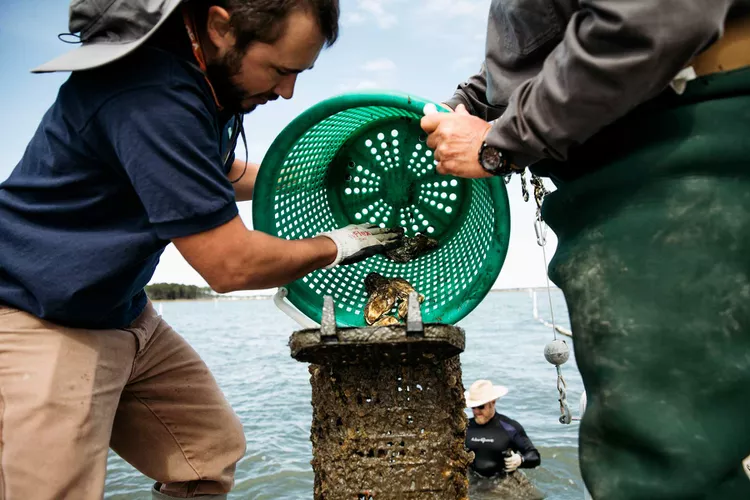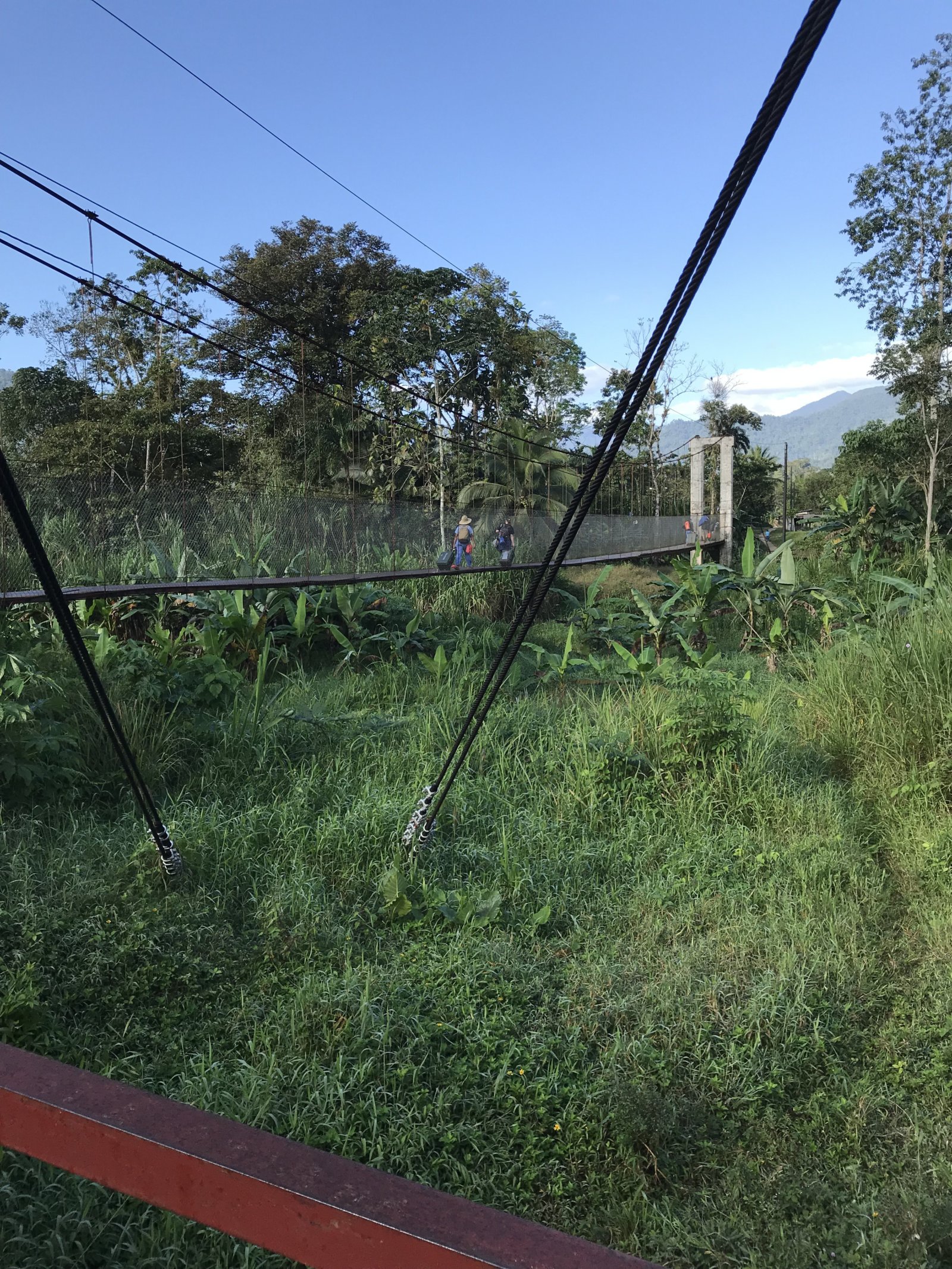Delaware’s Booming Oyster Farming Scene
“Four-hundred thousand oyster seeds can fit in the palm of your hand,” Mark Casey told me as we sat on the patio of his home on Delaware’s Indian River Bay. “But they’ll cover two acres when they’re fully grown.” That transition, he explained, happens quickly.
In 2018, soon after Delaware gave out its first permits for commercial oyster farming, Casey bought the 400,000 seeds that would become the family business. Every four days, those seeds — the term for nascent oysters, each as small as a grain of sand — would double in size. Within a month, what was once a cluster the size of a softball had spread the length of a 100-foot wooden dock, the juvenile shellfish housed in a grid of black mesh bags that bobbed on the water’s surface like sentient buoys. It’s intensive labor, cleaning the cages and scrubbing the shells — like taking care of an infant. Or half a million infants.
At first, Casey told me, they felt like they “were drowning in oysters.” However, he and his team — his wife, Lori, plus their children and spouses — survived the first year of ballooning bivalves. They now harvest three different varieties from their one-acre plot: Blue Hens, Delaware Salts, and Bethany Big Boys, from smallest to largest. Consequently, business at Delaware Cultured Seafood is booming.
On a windy weekend last September, I road-tripped from my home in Philadelphia to visit their operations and do some exploring in southern Delaware — a region that locals call Slower Lower Delaware, for its breezy way of life. A two-hour drive straight down Route 1, the state’s main artery, takes you through Wilmington and vast swaths of farmland, eventually arriving at the Atlantic coast. Although the towns here are home to plenty of year-rounders, Lewes, Rehoboth, Dewey, and Bethany swell with warm-weather visitors who come to experience dune-fringed beaches and all the trappings of a classic seaside vacation.

I grew up in Pennsylvania, but attended high school right over the border, where I learned firsthand how proud locals are of anything from the country’s second-smallest state. In college, I served overcooked lobster dinners at the now-closed Coconuts in Dewey Beach, a party town where red Solo cups were as essential an accessory as sunglasses. Nevertheless, southern Delaware had an ambitious food scene even then. And 20 years later, the region is attracting more and more food-industry talent, who draw from the orchards and family-owned farms that cover more than a third of Sussex County.
At Heirloom (entrées $28–$33), which occupies a restored Victorian house in Lewes, head chef Matthew Kern has been a James Beard Award semifinalist for the past two years. I understood why when I tasted the hand-pulled burrata layered with pumpkin brittle and shaved apple that kicked off my dinner on the restaurant’s charming patio. Nearby, Leisa Berlin, a fixture of the restaurant scene since the early ’90s, recently opened the café Station on Kings (entrées $11–$15) with her daughter, pastry chef Laura McKeown. I mulled over the pastry case — stacks of pastel macarons, made-from-scratch donuts filled with Honeycrisp-apple jam — before landing on the icing-cloaked cinnamon bun, which I enjoyed at a table in the garden. Heading south, I ordered a flight at Dewey Beer Co., known for its tart and juicy sours, and another at the iconic Dogfish Head Brewery, which was Delaware’s first brewpub when it debuted in Rehoboth Beach in 1995. The brand has since expanded to open more restaurants, along with the 16-room Dogfish Inn (doubles from $169) in Lewes.
Local ingredients are paramount at all these places — but until recently, when it came to oysters, “local” meant Maryland or Virginia. Delaware was the first state to ratify the U.S. Constitution, in 1787, but the last on the East Coast to legalize commercial oyster aquaculture. The state finally granted the first leases to commercial growers in 2017. However, the harvesting of wild oysters has deep roots in the region, according to Ed Hale, an aquaculture expert at the University of Delaware. In the 19th century, Delaware oysters stocked raw bars in New York and Philadelphia — so lucrative that they were nicknamed “white gold.” In the mid-20th century, a combination of overharvesting, pollution, and disease caused the population to plummet, and the industry faded away.
NYC’s Iconic Grand Central Oyster Bar Announces Return After Months-long Closure
The current renaissance has been a decades-long collective effort from the Delaware Center for the Inland Bays, among others, to restore habitat, conduct studies, and develop a plan and legal framework for how oyster farming would work. A significant reason for bringing it back: keeping the area’s waterways healthy for other marine life. Oyster farming is one of the most sustainable commercial activities on the planet, Hale conveyed. One adult oyster can filter up to 50 gallons of water daily, removing harmful nitrogen and phosphorus as it consumes algae. The delicious shellfish is a nice bonus.
“I knew it was gonna be a good oyster,” Dan Casey, Mark’s son, expressed while I toured the Delaware Cultured Seafood home base. “It’s the only reason I said yes to this.” Their plot in the Indian River Bay, one of three inland bays in the region where oyster farming is thriving, has a general salinity of 25 parts per thousand, which he said is ideal. He handed me a Delaware Salt. The deep cup of its shell, formed by tumbling the cages during the growing process, created a perfect nook for the oyster to soak up the briny water sealed inside. Dan was right. It was indeed a good oyster.
Moreover, there are other Southern Delaware operations joining the Caseys, many of them also family-owned. At Tower 3 Oyster Company, on Rehoboth Bay, owner Chuck Gifford sometimes gives first dibs to friends and neighbors, selling freshly harvested shellfish right off the back of his boat. Alan Davis, founder of nearby Arrowhead Point Oysters, grew up working on the water for his dad’s lobster business. “We’re bringing back an industry that’s doing some environmental good, hopefully for decades and more,” Davis remarked. “It’s nice to be a part of that.”

During my visit, Delaware’s white gold was just beginning to reappear on menus. “To have oysters actually coming from our Inland Bays — that’s awesome,” said Joe Baker, co-owner of Henlopen City Oyster House (entrées $28–$46), in downtown Rehoboth. “The days of going to a beach town and only eating fried seafood baskets are gone.” The sunlit space is filled with butcher-paper-lined tables, but I chose to sit at the bar, where an affable shucker named Jasper kept me company while I sampled my way through a half-dozen oysters. Baker and his business partner, Chris Bisaha, are excited to finally highlight the homegrown oysters, making plans to bring in oysters from Delaware Cultured. “I was actually blown away by how salty they were,” Baker mentioned. “That’s a benchmark for us.”
Chesapeake & Maine (entrées $19–$27), a Dogfish Head restaurant in Rehoboth, will soon feature Arrowhead Points on its raw bar. Meanwhile, I found some nearby at Fins Ale House & Raw Bar (entrées $14–$30) on Rehoboth’s Coastal Highway, which also serves the Casey family’s Delaware Salts — $9 for a half dozen during happy hour. At Bluecoast Seafood Grill (entrées $17–$42), oysters from Delaware Delicious, another local farm, come in shooters (with vodka or champagne) or on the half shell. On the deck overlooking the salt pond, I rounded out dinner with Bluecoast’s “oyster month” special: baked crab-stuffed oysters fragrant with Old Bay, plus a slice of tart lime pie.
On my last evening in Delaware, I assisted the Caseys in pulling up the day’s harvest. However, before heading out on the boat, Lori set a plate on the patio table. The spread included bacon-flecked baked oysters, deftly shucked raw oysters with thick lemon slices and cocktail sauce, and plump fried oysters breaded with pancake mix and crushed Club crackers, reminiscent of her dad’s preparation. The industry here is brand-new, still gaining traction. But soon enough, people will once again be bragging about these oysters. I’ve heard they grow fast.
A version of this story first appeared in the September 2021 issue of GoTravelDaily under the headline Shelling Out.





